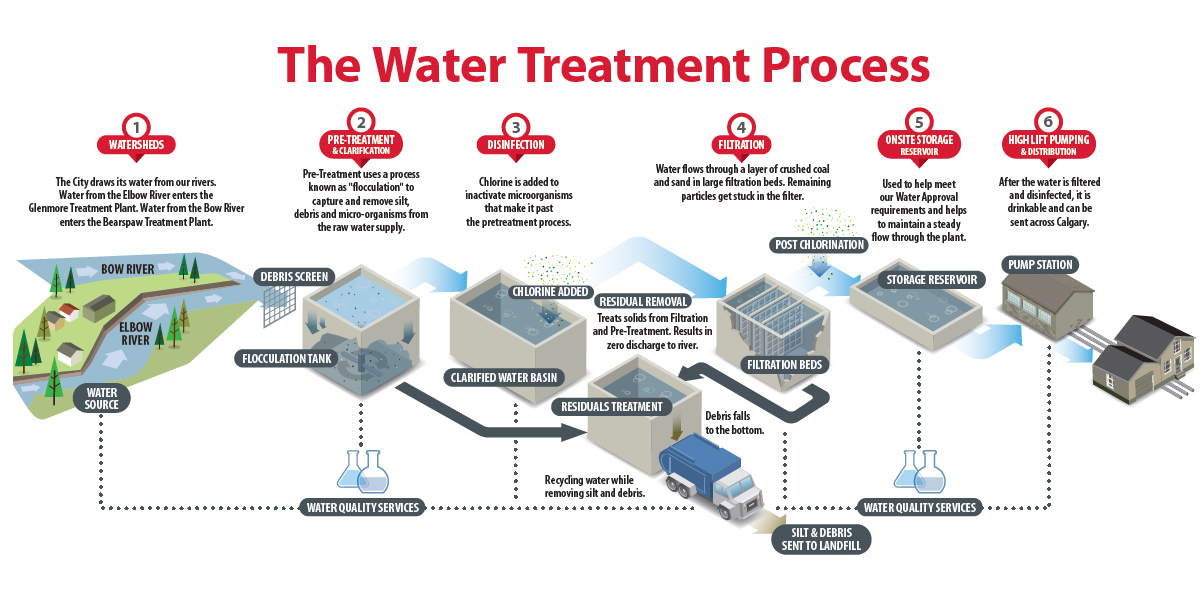Things about House Water Treatment
Table of ContentsHouse Water Treatment for BeginnersSome Of House Water TreatmentHow House Water Treatment can Save You Time, Stress, and Money.House Water Treatment Things To Know Before You Get ThisHouse Water Treatment Things To Know Before You BuyThe Definitive Guide to House Water Treatment
A phosphorous substance is included in aid regulate deterioration of pipelines. This aids prevent lead and copper that might exist in pipes from seeping right into the water. As the water leaves the plant, ammonia is contributed to transform the chlorine to chloramine, an anti-bacterial that keeps a recurring in the circulation system versus bacterial contamination.All chemicals that are added are licensed food grade, risk-free for use in foods. Treated water is kept in deep underground tanks as well as additionally flows by gravity to pumping terminals and into the distribution system. The distribution system consists of 1,960 miles of water pipe varying in diameter from 4" to 60".
Elimination of taste as well as smell substances from the water.: Softens the water.: Filtration to remove small particles and sanitation to kill viruses and germs, and ensure an unsuitable setting for infection and microorganisms growth throughout the circulation system.
The 6-Second Trick For House Water Treatment

According to the EPA, The Clean Water Act (CWA) develops the fundamental structure for regulating discharges of toxins right into the waters of the United States and also regulating quality requirements for surface waters. Under the CWA, EPA sets wastewater requirements for sector. The EPA has also established national water quality criteria referrals for contaminants in surface waters.
Associated White Documents Select Products Phase Two Testing Elimination of grit by streaming the influent over/through a grit chamber. Fine grit that locates its way right into the influent demands to be eliminated to prevent the damages of pumps as well as equipment downstream (or effect water circulation). As well tiny to be screened out, this grit requires to be removed from the grit chamber.
The smart Trick of House Water Treatment That Nobody is Discussing
Phase 4 Aeration Air is pumped into the aeration tank/basin to motivate conversion of NH3 to NO3 as well as offer oxygen for bacteria to continue to multiply and also expand. Once converted to NO3, the germs remove/strip oxygen particles from the nitrate particles and also the nitrogen (N) is produced as N2 (nitrogen gas) (house water treatment).
This begins in the aeration storage tank. The main Continue feature of the oygenation container is to pump oxygen right into the container to encourage the break down of any type of organic material (as well as the growth of the germs), in addition to make certain there suffices time for the natural product to be broken down.
This procedure is handled to use the investigate this site ideal conditions for bacterial growth. Oxygen gas [O2] levels listed below 2 ppm will certainly exterminate the bacteria, decreasing efficiency of the plant. Dissolved oxygen monitoring at this stage of the plant is important. Ammonia and also nitrate dimensions are common to measure just how reliable the germs remain in converting NH3 to N2.
Some Ideas on House Water Treatment You Need To Know
Phase Five Secondary Clarifier Dealt with wastewater is pumped right into a secondary clarifier to enable any type of continuing to be natural sediment to clear up out of cured water circulation. As the influent leaves the aeration process, it flows right into an additional clarifier where, like the primary clarifier, any really little solids (or penalties) sink to the base of the storage tank.
Part of this turned on sludge is gone back to the oygenation container to increase the bacterial focus, aid in proliferation, and also increase the malfunction of natural material. The excess is thrown out. The water that streams from the second clarifier has actually substantially minimized natural product and also should be approaching anticipated effluent specs.
With the improved focus of microorganisms as part of the oygenation stage, there is a demand to examine the outgoing effluent for microorganisms visibility or absence and to disinfect the water. This makes sure that greater than defined focus of germs are not launched right into the setting. Chlorination is one of the most typical and also cost-effective sort of sanitation yet ozone and also UV sanitation are also boosting in popularity.
What Does House Water Treatment Do?

After enough time, bits adhere to each other and expand right into bigger bits, or, floc, which is prone to settle in water. Clarification of water is accomplished by the seperation of suspended solids from water by gravity.
The made clear water actions up slowly, at some point overlooking the effluent dam to the cone outlet and on the to filters for additional treatment. The water plant incorporates a solitary phase lime softening operation to remove solidity. Firmness is caused by the visibility of dissolved bivalent and polyvalent steel ions, primarily calcium and magnesium. house water treatment.
Indicators on House Water Treatment You Should Know
This is added both in the clearwell and also the high service discharge as water gets in the distribution system. Hydrofluosilicic acid This Site provides the source of fluoride, which is valuable in the prevention of tooth decay in children. A fluoride concentration of 1. 1-1. 2 mg/l is generally desirable in the plant tap.